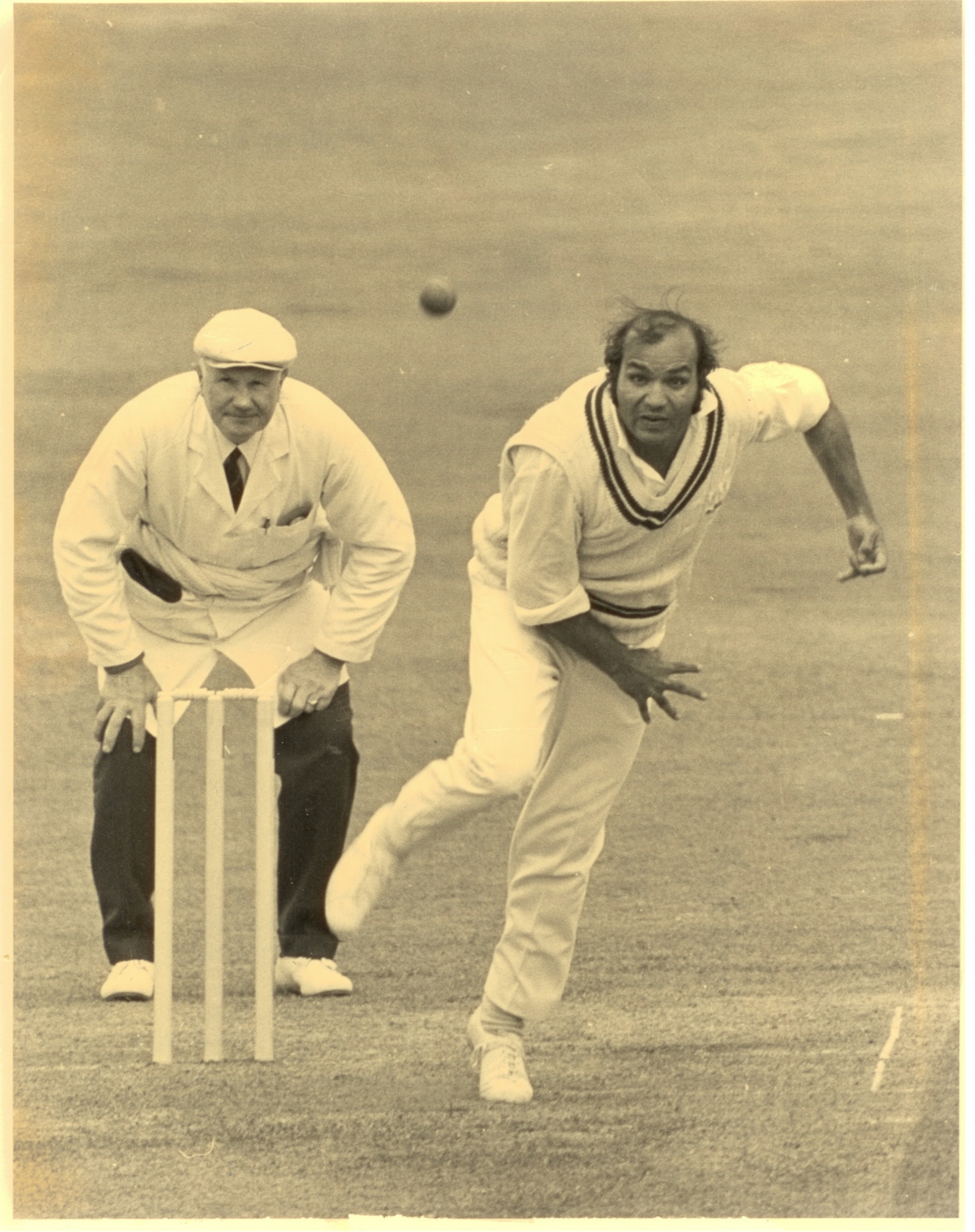Two major changes – signing their first overseas player and the introduction of Sunday League cricket – gave Surrey plenty to anticipate as they approached the 1969 season. But first they came to terms with the loss of a stalwart. Richard Spiller looks back
SURREY’S YEAR
There was a sad start to the new year when Ken Barrington announced his retirement.
Having just turned 38, he had been the foundation stone of Surrey and England’s batting for a generation but ill health and mental stress which dogged him through the 1968 summer culminated in a heart attack while playing in the World Double Wicket Tournament in Melbourne.
Barrington recuperated while sailing home with his wife Ann but decided his playing days were over, informing Surrey and England and then announcing his retirement in an interview on Sportsnight with Coleman in January.
In 82 Tests, Barrington had scored 6,806 runs at 58, placing him among the greats of the game, often laying the foundations for others to build upon. His 31,714 first-class runs came over 533 matches, along with 273 wickets bowling leg-spin.
“With those craggy features and that strong, thick-set figure, he was a symbol of defiance,” wrote John Woodcock, cricket correspondent of The Times, in Wisden Cricketers’ Almanack for a piece “Ken Barrington – The Accumulator”.

Yet from that start it turned to be a vastly happier summer for Surrey after the depression of 1968, when an injury-addled squad slumped to 15th in the County Championship, their worst finish for seven years and joint-lowest in the club’s history at that stage. Little seemed to go right, John Edrich’s three centuries the only ones recorded by a Surrey player while injury limited spearhead Geoff Arnold to one match and vastly reduced the effectiveness of all-rounder Stewart Storey a year after he had completed the double.
Surrey had not been among the counties who took advantage of a rule change to register an overseas player. Barry Richards scored swashbuckling runs for Hampshire, fellow South African Mike Procter’s all-round talents shone for Gloucestershire and Asif Iqbal’s flair was on show for Kent. Nowhere was the change in a team’s fortunes more dramatic than Nottinghamshire, who had only spent one season in the past 11 outside the bottom three yet now shot up to fourth on the coattails of Garry Sobers. Captain of West Indies and still regarded by many as the greatest all-rounder to play the game, his performances were highlighted by becoming the first man in the history of the game to hit six sixes in one over, despatching Malcolm Nash around Swansea.
If Surrey could not capture such an exotic talent, they could afford to be pleased with the capture of Intikhab Alam, whose leg-spin was regarded as a dying art in England and came with some hard-hitting contributions in the lower order. “Inti” quickly became a popular figure with both his colleagues and supporters and The Oval would remain his home until 1981.
With Barrington gone, skipper Micky Stewart was the only member of the barnstorming 1950s team remaining and his mission to recapture the summit, finally achieved two years later, was back on track. Although Surrey had to wait until their sixth Championship match for a win – beating Kent by five wickets at The Oval – another soon followed against Gloucestershire. A series of stalemates proved frustrating but August brought a string of victories.
It wasn’t enough to mount a serious challenge to champions Glamorgan, who finished 31 points clear of the pack, but seven wins in 24 outings and just one defeat earned third place, nine adrift of surprise package Gloucestershire.
Edrich – when not opening for England in six Tests – was again the outstanding run scorer with 1,416 at 74 and this time there were five players sharing 14 tons. The wristy Younis Ahmed’s 1,449 at 43 were joined by opener Mike Edwards making 1,114 at 33. Stewart’s 996 at 38 and emerging Graham Roope’s 934 at 32 underlined the solidity of the batting.
Roope underlined his talent in a tour match against West Indies, a haul of 5-14 in dismissing the tourists for 160 followed by making 97 out of 344-8 in a drawn match. New Zealand got the better part of a draw when they visited in July.
Arnold’s return to fitness, until suffering a bruised heel in the Oval Test, sharpened Surrey’s pace attack, gangly youth Bob Willis indicating the promise of so much to come by breaking into the side with 17 cheap wickets. Off-spinner Pat Pocock enjoyed having Intikhab at the other end, the pair taking 65 and 62 wickets respectively.
Cricket on Sunday had hitherto been mainly benefit matches but now the Sabbath would stage the new 40-over competition, initially called the Players County League (morphing to the John Player League or JPL soon after). Crowds soon caught on to a game which began at 2pm and would be over before 7pm, even if most quicker bowlers did not appreciate having their run-ups limited to 15 yards to help with the over-rate.
Surrey made an excellent start with three wins, all “home” matches although one of them was at Sutton’s Cheam Road ground, nine victories in 16 matches enough to secure fifth position of a competition won by Lancashire in the first year. But they were n the wrong end of a remarkable feat at Lord’s when Middlesex seamer Bob Hooker claimed 6-6 in eight overs to be all out for 83 and lose by 29 runs.
An encouraging Sunday start compensated, at least in part, for going out of the Gillette Cup in the second round – defeated by eventual champions Yorkshire – with Arnold’s 25 wickets at 13 making him the team’s outstanding limited overs bowler.

OVAL TEST
So much had changed for England since their thrilling victory in the dying moments of the Ashes series 12 months earlier– except for the main protagonist.
Derek Underwood was the man who had prised out Australia’s tail, every fielder crowded around the bat, to earn England a share of that contest.
Now he took 12 wickets, six in each innings, to sew up a 2-0 victory over New Zealand. The cast around him had changed radically. Colin Cowdrey’s torn achilles in May had opened the way for Ray Illingworth – having only just taken charge of Leicestershire after falling out with Yorkshire – to show immediately he was a shrewd and unyielding captain.
Not only Cowdrey was missing. Tom Graveney was left out after the opening Test of the summer for playing a testimonial match during the rest day and tragedy had struck Colin Milburn, who lost an eye in a car crash. Without Barrington’s reassuring presence in the middle-order, there was a radically different look to England’s batting.
England had already beaten West Indies 2-0 in the first half of the summer, the tourists no longer possessing their twin pace threat of Hall and Griffith, depending increasingly on the brilliant but tiring Sobers.
Next came New Zealand, beaten by 230 runs at Lord’s before a draw at Trent Bridge, Surrey’s Edrich making centuries in both matches.
For the final match of the series, England recalled Geoff Arnold on his home ground to form a powerful pace trio with John Snow and Alan Ward – the Derbyshire paceman tipped for great things – yet they would largely prove bystanders in a match dogged by showers in which the total attendance was around 20,000.
New Zealand captain Graham Dowling could afford to be happy when his side reached 68-1 on day one, a shower just after lunch livening up the pitch. Few used such conditions better than “Deadly Derek” Underwood. Although Glenn Turner battled through more than three hours in making 53, the Kiwis were 123-7 when rain returned to finish the action, Underwood polishing them off the next morning for 150 to finish with 6-41 and his captain claiming 3-55.
If Edrich (68) and Geoffrey Boycott (46) found the going much easier in an opening stand of 88, newcomer Mike Denness’s tortured maiden innings of two from 43 balls spoke both of nerves and the persistence of an attack in which Bruce Taylor (4-47), Bob Cunis (3-49) and Hedley Howarth (2-66) rarely offered gifts. Phil Sharpe (48) and Alan Knott (21) were the only others to reach double-figures until 21 apiece from Snow and Ward lifted England to 242 all out on a rain-ruled third day in which only 90 minutes play was possible.
That lead of 92 might threatened to be decisive when Underwood struck twice quickly but New Zealand’s resistance centred on Brian Hastings, battling his way to 61 in more than three hours. Arnold’s Test – and the rest of his season – was terminated by a sore heel but Snow and Ward struck twice. Underwood was still the main threat, though, this time picking up 6-60 from 38.3 miserly overs to claim the best match figures for an England bowler against the Kiwis.
Setting out to make 138 to wrap up the series, the hosts were 32-1 going into a final day, with more rain forecast. Just 10 runs were needed when a heavy shower hit the ground just before lunch and there were worries it might end the game. But when it relented Denness was able to make a half-century on debut – finishing 55no – while Sharpe’s 45no helped him to complete victory by eight wickets.
WHAT ELSE HAPPENED IN 1969?
“That’s one small step for man, one giant leap for mankind.”
Those were the immortal words spoken by American astronaut Neil Armstrong in putting his left foot on the surface of the Moon, witnessed by a global audience of 650 million. The crew of Apollo 11 had rewarded their country’s human spaceflight programme, set up in 1960, by reaching the Moon before making it safely back, a task for so long felt to be impossible.
The reflected glory was enjoyed by new president Richard Nixon, the 37th holder of that office, one of his tasks being to get America out of the Vietnam War which had dogged his predecessor Lyndon Johnson. It would take him another four years. Nixon had been vice-president to Dwight D Eisenhower in 1952-60, his old boss – the Supreme Allied Commander of the Second World War – dying in March, aged 78.
France and Britain both carried out test flights of the supersonic jet Concorde, which they had been developing jointly, while in the USA the Boeing 747 “jumbo jet” took off for the first time.
Charles De Gaulle, leader of the Free French in WW2 and president of France since 1959, resigned after suffering defeat in a constitutional referendum. He was replaced by Georges Pompidou.
The Beatles released their Abbey Road album but were heading towards breaking up. Their final public performance was staged on the roof of Apple Records in London until broken up by the police. John Lennon and Yoko Ono celebrated their marriage with a public sleep-in to publicise their desire for peace.
Sir Matt Busby announced his retirement as manager of Manchester United, who had won the European Cup the previous year.
Leeds United, coached by Don Revie, claimed the Football League Championship for the first time in their history. Manchester City won the FA Cup, beating Leicester City 1-0 at Wembley.
Tony Jacklin won the Open Championship at Royal Lytham, finishing two strokes ahead of Bob Charles, the first Briton to claim the crown since 1951.
Defending champion Rod Laver beat fellow Australian John Newcombe to secure his fourth Wimbledon men’s singles title, helping him towards a second grand slam. Early attention had been snatched by a second round contest in which 41-year-old Pancho Gonzales beat Charlie Pasarell 22-24 1-6 16-14 6-3 11-9, which prompted the introduction of tie-breakers.
Ann Jones became the first British winner for eight years when she beat Billie-Jean King in the women’s singles, prevailing 3-6 6-3 6-2. She also partnered Fred Stolle to the mixed doubles title.
Inspired by Barry John at fly-half, Wales claimed the Five Nations Championship, winning three matches and drawing the other to finish one point ahead of Ireland.
It was an exciting year for youngsters. The space hopper toy enabled them to bounce around while, on television, The Clangers offered a new angle on space exploits and remains a favourite to this day.










